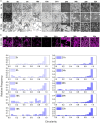Black phosphorus/silk fibroin films hamper filamentous and invasive growth of Candida albicans
- PMID: 39664243
- PMCID: PMC11632600
- DOI: 10.1039/d4ra05126b
Black phosphorus/silk fibroin films hamper filamentous and invasive growth of Candida albicans
Abstract
The ability of fungi and bacteria to form biofilms on surfaces poses a serious threat to health and a problem in industrial settings. In this work, we investigated how the surface stiffness of silk fibroin (SF) films is modulated by the interaction with black phosphorus (BP) flakes, quantifying the morphogenesis of C. albicans cells. Raman and infrared (IR) spectroscopies, along with scanning transmission electron microscopy, allowed us to quantify the thickness and diameter of BP flakes dispersed in the SF matrix (e.g., 5.5 nm in thickness and 20 μm in diameter), as well as an increase in beta-sheet secondary structures, resulting in the mesoscopic formation of a globular and nanofibrous surface. The formation of β-sheet crystals in the SF/BP film was correlated with a higher surface stiffness, influencing the shape of C. albicans cells and suppressing their filamentous growth. Raman spectroscopy analysis ultimately suggests an overall reduction in cell vitality and filmogenic capability of cells grown on fibroin-based films containing BP. Our results suggest that the conformational properties of SF can be suitably tuned to design optimized bioselective coatings for biomedical applications.
This journal is © The Royal Society of Chemistry.
Conflict of interest statement
There are no conflicts to declare.
Figures





References
-
- Zhang W. Chen L. Chen J. Wang L. Gui X. Ran J. Xu G. Zhao H. Zeng M. Ji J. Qian L. Zhou J. Ouyang H. Zou X. Adv. Healthcare Mater. 2017;6:1700121. - PubMed
-
- Choudhury A. J. Gogoi D. Chutia J. Kandimalla R. Kalita S. Kotoky J. Chaudhari Y. B. Khan M. R. Kalita K. Surgery. 2016;159:539–547. - PubMed
-
- Schnaider L. Toprakcioglu Z. Ezra A. Liu X. Bychenko D. Levin A. Gazit E. Knowles T. P. Nano Lett. 2020;20:1590–1597. - PubMed
-
- Fei X. Jia M. Du X. Yang Y. Zhang R. Shao Z. Zhao X. Chen X. Biomacromolecules. 2013;14:4483–4488. - PubMed
LinkOut - more resources
Full Text Sources

